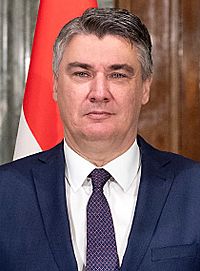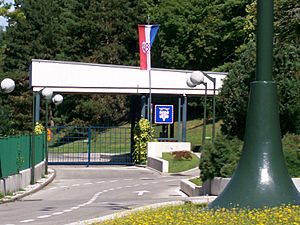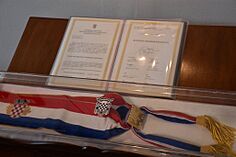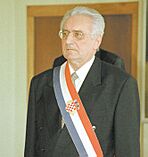President of Croatia facts for kids
Quick facts for kids President of the Republic of Croatia |
|
|---|---|

|
|

Coat of arms of the president
|
|
| Office of the President of the Republic | |
| Style | Mr President (informal) His Excellency (diplomatic) |
| Member of | Armed Forces of Croatia |
| Reports to | Croatian Parliament |
| Residence | 36 Krajiška Street, Zagreb |
| Seat | Predsjednički dvori, Zagreb |
| Appointer | Popular vote |
| Term length | Five years
renewable once
|
| Constituting instrument | Constitution of the Republic of Croatia (1990) |
| Inaugural holder | Franjo Tuđman |
| Formation | 22 December 1990 |
| Deputy | Speaker of the Croatian Parliament |
| Salary | € 72800 annually |
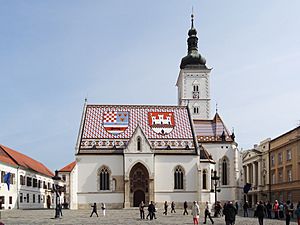
The President of Croatia is the official head of state of the Republic of Croatia. This means they are the top representative of the country, both at home and when dealing with other nations. The president is also the commander-in-chief of Croatia's military.
Even though the president holds the highest office, Croatia has a parliamentary system. This means the Prime Minister usually has more power in the day-to-day running of the government. The president's main job is to make sure the government works smoothly and to protect Croatia's independence and borders.
Contents
What Does the President Do?
The president has several important jobs. They help keep the government stable and protect the country's independence.
Calling Elections and Appointing Leaders
- The president can call regular or special elections for the Croatian Parliament.
- They can also call referendums, which are votes where citizens decide on important issues.
- The president formally chooses the Prime Minister. This choice is based on which political party has the most power in Parliament.
- They also grant pardons (forgiving someone for a crime) and give out state awards.
Working with Other Countries
- The president and the Government work together on Croatia's foreign policy. This means they decide how Croatia interacts with other countries.
- The president helps set up Croatian embassies and consulates abroad.
- They also appoint and welcome diplomats from other countries.
Leading the Military and Security
- The president is the top leader of the Croatian Armed Forces.
- They appoint military commanders, like the chief of staff.
- The president also works with the government to guide Croatia's security and intelligence agencies.
- They can attend government meetings and lead councils related to defense and national security.
Special Powers in Emergencies
- If there's a war, the president can declare it and make peace, with Parliament's approval.
- In serious emergencies, like a threat to the country, the president can order the military into action.
- They can also make special rules that have the power of law during a war or crisis, but these usually need to be approved by the Prime Minister and later by Parliament.
Dissolving Parliament
- The president can dissolve the Croatian Parliament in certain situations.
- For example, if the government loses a vote of confidence or if a new government can't be formed after elections.
- This decision usually needs the Prime Minister's approval.
The President's Office
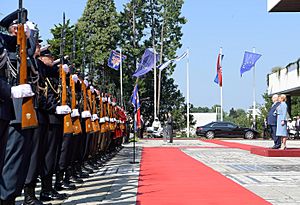
The president has an official team and support staff called the Office of the President of the Republic. This office is located in the Presidential Palace in Zagreb. The president doesn't live there, but it's their main workplace.
The Presidential Palace was originally built in 1964. It became the official workplace after the original government building was bombed in 1991.
How is the President Chosen?
The president is elected by the people of Croatia through a secret vote.
Presidential Elections
- People vote for a president every five years.
- To win, a candidate needs more than 50% of all votes.
- If no one gets more than 50% in the first round, the top two candidates have a second vote (a "runoff election").
- A president can only serve two terms in office.
- To become a candidate, a person must be at least 18 years old and get support from 10,000 voters.
Taking Office
- Once elected, the new president must leave their political party.
- They also have to resign from Parliament if they were a member.
- Before starting their job, the president takes an oath of office. This is a special promise to be loyal to Croatia's Constitution.
- The inauguration ceremony, where the oath is taken, usually happens at St. Mark's Square in Zagreb.
Past Presidents and Elections
- Franjo Tuđman was the first president of modern Croatia, elected in 1992 and 1997.
- After his death in 1999, the Constitution was changed. Many presidential powers were moved to the Parliament and the Prime Minister.
- Stjepan Mesić served two terms, from 2000 to 2010.
- Ivo Josipović was president from 2010 to 2015.
- Kolinda Grabar-Kitarović became the first woman president in 2015.
- The current president, Zoran Milanović, won the election in 2020 and took office on February 19, 2020. He was re-elected in 2025.
List of Presidents
Here's a timeline of Croatia's presidents since 1990:
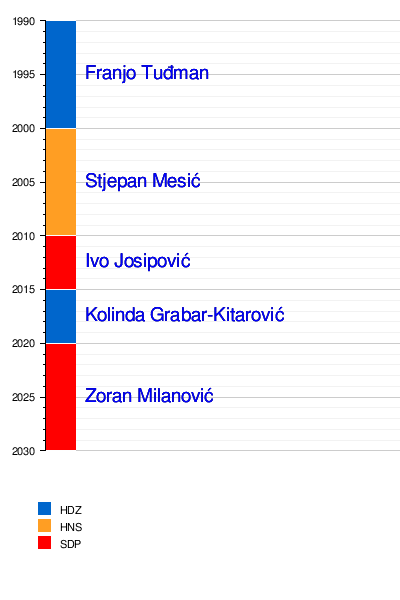
What Happens if the President Can't Work?
If the president is temporarily unable to do their job (for example, due to illness or travel), they can transfer their powers to the Speaker of the Parliament. The Speaker then acts as the temporary president.
If the president dies, resigns, or is removed from office, the Speaker of the Parliament becomes the acting president. In this case, a new presidential election must be held within 60 days. This happened in 1999 after President Franjo Tuđman passed away.
Symbols of the President
The president has special symbols that represent their office:
- Presidential Standard: This is a special flag. It's a blue square with a border of red and white squares. In the middle, it has Croatia's coat of arms. This flag is flown at the Presidential Palace and on vehicles the president uses.
- Presidential Sash: This is a colorful band worn diagonally across the president's body. It has the Croatian flag colors and the coat of arms. Presidents wear it on important national holidays and during special ceremonies.
Life After Presidency
After their term ends, former presidents of Croatia receive some support from the state. They get an office, a few staff members, a driver, a car, and bodyguards. This helps them continue to contribute to public life. For example, former president Stjepan Mesić used his office to help Croatian companies and meet with foreign diplomats.


